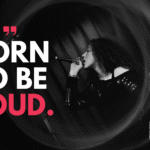Now Reading: Reviving What We’ve Lost in the Capitalistic Economy of Distraction –
-
01
Reviving What We’ve Lost in the Capitalistic Economy of Distraction –
Reviving What We’ve Lost in the Capitalistic Economy of Distraction –

There’s a difference between hearing music and really listening. Hearing is passive. Deep listening is active. In a world drowning in noise—Spotify playlists, algorithmic recommendations, the endless scroll—most of us hover on the surface. We let music wash over us. It plays while we commute or while we do chores. We “like” a track after Spotify has thrown it at us five times. But do we ever pause to wonder what else is there tucked into the songs, what the artist meant, how it might shift us? That capacity, the ability to connect beyond the obvious, is slipping away. And for musicians, that gap between hearing and listening might be the difference between a forgettable single and something that roots itself into people’s souls.
Drawing from Jenny Odell’s insights in How to Do Nothing, this article breaks down what deep listening means for listeners and musicians. It critiques our modern-day attention economy. It asks whether we can ever return to a place of undistracted immersion—lying back, shutting everything else off, drinking in music. And it offers hope. Because even though the system seems rigged for fragmentation, there are ways to resist. Ways to demand something more for creators and consumers.
The Illusion of Choice: Why “More” Often Means Less
We live in an era where access to music has never been greater. Hundreds of millions of tracks at our fingertips. Yet all this abundance often dilutes experience rather than enriches it. Algorithms suggest what to listen to, and trending playlists dictate what we “should” enjoy. We’ve got oceans of options, but rarely swim deep in any direction. We’re always semi-sated on the shore, superficialy dipping our toes.
The problem is attention. Tech platforms are engineered so that music consumption remains easy, uninterrupted, and incidental. A song plays while you check messages, while you cook dinner, while your brain is already half somewhere else. You hear it. But you don’t listen. You don’t lean in to hear the quiet guitar strum at 2 minutes 14 seconds. You don’t catch the nuance in the singer’s voice when it cracks. You don’t think, Who is this person? What drives them? What’s their story? Because the system encourages volume and speed, not depth.
That illusion of choice becomes conformity. If everyone streams what the algorithm favours, then “popular” gets louder. Obscure artists scramble for scraps of attention. Genuine connection becomes secondary to clicks.
Deep Listening: What It Actually Is, and Why It Matters
Deep listening means slowing down. It means rejecting passive consumption. It means recognising that music is not wallpaper. It requires curiosity, attention, and time. When you deep listen, you’re attuning to the layers—the production, the words, the space between notes, the emotion that trembles just under control. You seek the artist’s intention, you question your own. You let the music dwell in you for longer. You might listen again, you might explore who else they are, what they believe, where they come from.
For musicians, this is transformative. If you write music knowing someone might deeply listen, you care about every choice: the lyrics, the arrangement, the dynamics. You shape silence as much as sound. You invest in texture. You take risks that reward the ear that stays. Because these are the kinds of listeners who buy tickets, who become ambassadors of your work, who tell their friends because they’ve felt something. A casual hearer might press skip tomorrow. A deep listener will come back.
The Death of Unplugging: When Distraction Became Default
Once upon a time, people would unplug. Lie back in a room with nothing but music. No phone. No notifications. The whole self surrendered to the record spinning. We listened with our whole bodies. We felt weight in the bass, breath in the vocals.
That seems mythologised & strangely romanticised now; that image of someone entombed of someone lay surrounded with LP artwork and legs curled behind them. We carry devices everywhere. Even live shows are ruined by faces lit by phone screens. Playlists follow us into beds, into gyms, into taxis. We become habituated with background sound. Music becomes one layer among many: ambient, forgettable, supporting the noise of everything else rather than demanding its own space. I can’t even say I’m the exception; these days, if I take headphones onto a train, it’s mostly so I can drown out the sound of luddites munching crips to the decibel of car tyres on gravel and sheild myself from the rancour of a toddler hopped up on sugar as the parents practice soft parenting or just sheer indifference to how their spawn is making people want to jump off the moving train.
Can we return to those unplugged moments? Possibly—but only if we act on the intention. We can habitually switch off devices when listening. We can turn off our phones at gigs, because let’s face it, you’re barely even listening to the music, why should your friends and followers after you post a reel on Instagram? The way we are consuming music in the modern era is the equivalent of having sex while we’re asleep; the sensation is there, but we don’t acknowledge the feeling.
The Artist in the Attention Economy: Connecting Beyond the Surface
The attention economy sells us the easiest path. It wants catchy chord progressions, relentless hooks, and the briefest lyrical pronouncements that jump right out. That’s fine if your aim is fleeting popularity. But if your ambition is for people to remember, to care, to invest—you need deeper connection.
For artists, the pressure to produce content constantly—single after single, social media posts, behind-the-scenes clips—pulls attention towards the surface. Fans see bits and pieces. They know nothing of the full portrait. They know the chorus, not the album’s architecture. The story becomes fragmented. They believe they know the artist because they’ve seen memes or stories. But they haven’t truly listened.
To break through, artists need strategy and integrity. Strategy in how to invite attention: perhaps through liner notes, in-depth interviews, thematic cohesion. Integrity in refusing to water down. Refusing to make tracks that just conform to what trends say. Creating work that demands time and attention. The risk is fewer instant streams. The reward is a loyal audience that stays, that champions you, that buys merch, that sees you live. That audience is rare but invaluable.
Conclusion: Rediscovering Listening as Resistance
In the cacophony of modern life, hearing music has become easy. Deep listening has become rare. Yet deep listening is more than devotion to art. It is resistance to capitalistic distraction. It is reclaiming value in an economy that wants to compress everything down to what’s swipeable, what’s shareable, what’s ignorable.
Musicians who yearn for connection beyond the surface have to insist on depth. Listeners who crave meaning have to refuse passive consumption. Together we can coax back the space of resonance, where we allow music to shift something inside.
Article by Amelia Vandergast
Artwork by Joseph Lee






















